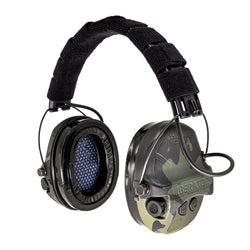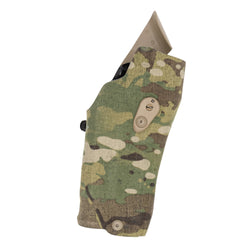February 23, 1945. Secretary of the Navy James Forrestal had just gone ashore on hotly-contested Iwo Jima. Despite heavy fighting only a few hundred yards away, Forrestal wanted to see the landing beaches where the first waves came ashore four days earlier. Supplies flowed steadily across the volcanic ash beaches under intermittent Japanese artillery fire, while wounded Marines were loaded onto the returning boats.

Lt. General Holland M. Smith, the top Marine in the Pacific, accompanied Forrestal ashore with a platoon of grim-faced leathernecks. Forrestal and Smith had just stepped onto the beach when a ragged cheer went up, eventually spreading to all the Americans on Iwo Jima and even the fleet standing offshore. Marines pointed up to Mount Suribachi, the 550-foot-tall dormant volcano occupying Iwo’s southern tip.
There, waving in the breeze, was the Stars and Stripes, raised by a 28th Marine Regiment patrol which had just achieved the summit. Forrestal turned to Smith and said, with feeling, “Holland, the raising of that flag on Suribachi means a Marine Corps for the next five hundred years.”
The flag-raising on Mount Suribachi is perhaps the most famous event in the Marine Corps’ 250-year history. The small flag the Marines carried as they assaulted the mountain was soon replaced by a larger flag rushed up from the fleet. Associated Press photographer Joe Rosenthal quickly snapped a photo as he saw, from the corner of his eye, the second flag going up. He hadn’t even had time to look through the viewfinder. Rosenthal sent the film back to Guam to be developed. AP photo editor John Bodkin saw the photo and exclaimed, “Here’s one for all time!” He quickly forwarded the photo to New York.

Bloody Iwo Jima
World War II was entering its final stretch when the 4th and 5th Marine Divisions stormed Iwo Jima on February 19,1945. The once-mighty Imperial Japanese Navy was no longer capable of offensive operations. American B-29s were pounding Japanese cities and US Navy carrier aircraft raided Tokyo with impunity. In Europe, the US Army was only two weeks away from crossing the Rhine River into Germany proper.
But the American public was war-weary, despite having it relatively easy compared to other home front populations. Casualties were mounting and, despite the constant wartime propaganda, neither enemy seemed ready to quit. Then rumors began circulating about the heavy death toll on a Pacific island called Iwo Jima.
Japanese commander Lt. General Tadamichi Kuribayashi was a veteran soldier and understood how to fight the American amphibious machine. He knew that defending the water’s edge would cost him heavily and do no good anyway. The Marines always got ashore thanks to heavy naval gunfire and endless airstrikes. So, he determined to make his enemy come to him.

His 22,500 men dug a warren of tunnels into the volcanic rock, creating interlocking strong points reinforced with steel and rebarred concrete. Each position was supplied and reinforced through the tunnel network. Belts of well-sited positions led from the landing beaches up the rising ground to Motoyama Plateau in the north and Mount Suribachi in the south. The Marines had to dig the Japanese out with explosives and flame throwers, one position at a time.
American newspapers had reported the invasion, along with photos of early operations, on February 21. Casualty figures were omitted, which was standard practice. But Iwo Jima was different. The Navy, and the government as a whole, tried to suppress the shocking figures, but word leaked out: Iwo Jima was a bloodbath.
The Iwo Jima Controversy
The Sunday newspapers of February 25 carried a striking photograph of six Marines raising the American flag on Mount Suribachi. But the reported costs of that flag-raising were still leaking out. General Douglas MacArthur, angling for overall command in the Pacific, heavily criticized Marine and Navy commanders, implying that they needlessly wasted their men’s lives.

Newspaper publisher William Randolph Hearst dictated a scathing editorial to the editor of the San Francisco Examiner a day later, lobbying for MacArthur’s elevation. “The attacking American forces,” he wrote, “are paying heavily for the island, perhaps too heavily… Plainly, what we need in all our Pacific operations is a military strategist.” MacArthur, he said, was the right man because “he saves the lives of his own men.”
But those uninformed gripes were soon silenced. One hundred off-duty Marines visited the Examiner’s offices the very afternoon Hearst’s editorial was published. They were polite but firm as they insisted on a face-to-face meeting with the editor to explain why Hearst was wrong.
Forrestal himself had directed the Navy and Marine Corps to be more open about allowing journalists access to combat areas. That policy now paid dividends as those men repudiated MacArthur and Hearst’s criticisms. The reporters touted the Marines’ bravery and fighting skill. They emphasized the brutal conditions on Iwo Jima and the nature of Kuribayashi’s island fortress. They put the lie to any notion that the Marines could do anything other than what they were doing and made it plain that the leathernecks were doing it very well indeed.
Army Air Force Commander General Henry ‘Hap” Arnold confirmed the absolute necessity of taking Iwo Jima to support the strategic bombing campaign against Japan. MacArthur and Hearst’s allegations were soon drowned out.
Rosenthal’s dramatic photograph became a fierce symbol of national pride.

The 500-Year Marine Corps
Forrestal’s comment about “a Marine Corps for the next 500 years” wasn’t just an off-hand remark. The Corps’ status as an independent service had been questioned for some time. The days of Marine sharpshooters ensconced in ships’ rigging were long gone, as were boarding parties for ships locked in mortal combat.
The First World War saw a Marine Brigade form half of the US Army’s 2nd Infantry Division as the 4th Brigade (Marine). Marine General John A. Lejeune ably commanded the division, much to the chagrin of many Army officers who had argued that Marine officers were incapable of handling large units. Not to mention their dislike of a Marine commanding Army troops (in fairness, World War II Marine officers strenuously objected to being placed under Army commanders).
World War I Marines distinguished themselves, earning the sobriquet “Teufel Hunden” from their German adversaries. You may know that name by its English translation: Devil Dogs. Their service led many to question why the United States needed what seemed to be a second Army that essentially did the same thing. Congress wondered the same thing as it looked to slash defense expenditures after the war.
Lejeune, who was now the Commandant of the Marine Corps, established a separate Marine identity by embracing amphibious warfare to solidify the Corps’ relationship with the Navy while distinguishing it from the Army. The plan worked, but Forrestal could see a similar argument looming as World War II entered its climactic months.
Forrestal pushed the Navy and the Corps to promote the Marines’ mission by granting increased access to journalists who could write about what they saw. He believed it would solidify the Corps’ image in the minds of the American public. His reaction to the flag-raising must be understood in that context.
Preserving the Marine Corps
Forrestal’s instincts were correct. President Harry Truman, advised by Army Chief of Staff General George Marshall, pushed for the Army to absorb the Marine Corps under the auspices of a Defense Department organized around three primary branches: Air, Ground, and Naval. The Corps would be reduced to regimental-sized units for naval security, minor raids, and ceremonial duties. General Dwight Eisenhower characterized distinct Marine missions as administrative details that the Army could assume.

Prominent World War II Marines, including Commandant A.A. Vandegrift, Colonel Merril B. Twining, Lt. Colonel Victor Krulak, and Colonel Merritt Edson drafted and delivered speeches in support of an independent Marine Corps, citing its wartime service and amphibious expertise. Vandegrift’s 1946 speech to the Senate Naval Affairs Committee outlined the national security dangers of Truman and Marshall’s proposal, while appealing to the Congressional authority that first established the Corps in 1798. (Like the Army and Navy, the Marines trace their origins to 1775, but formal establishment by the United States government did not come until later). Vandegrift vowed to continue the fight, telling the Senators that “The bended knee is not a tradition of our Corps.”
Forrestal himself prioritized retaining naval aviation in the face of a newly independent Air Force. But Vandegrift and others pressured him to lift testimony restrictions that kept Marine officers from defending the Corps in Congress and in the public eye. He also pushed for including the Marine Corps within the Defense Department’s Naval component.
Lobbying efforts forced the Joint Chiefs of Staff to release classified documents regarding the new organization. Public opinion swung firmly against the merger, and Truman agreed to establishing the Corps as an independent service branch as part of the National Security Act of 1947. Forrestal’s PR campaign, and Rosenthal’s photo, had paid dividends with the public.

The Iwo Jima Photo’s Enduring Legacy
Joe Rosenthal almost missed his photo. He snapped it instinctively as his eyes caught the movement. He didn’t even see the image until after it was published, though it won him a Pulitzer Prize.
A misunderstanding led to accusations that Rosenthal staged the photo, despite the fact that Sergeant Bill Genaust, a Marine Combat Cameraman, filmed the event from almost the exact same angle, proving that it was genuine. The footage survives in the National Archives and can be viewed online. But the allegation almost caused Rosenthal’s Pulitzer to be revoked and persists to this day. Genaust was unfortunately killed in action eight days later. His remains were never recovered.
President Franklin Roosevelt immediately recognized the photo’s propaganda potential. Make no mistake, propaganda was an important tool in maintaining public morale and financing the war effort. Rosenthal’s photo was appropriated for the 7th War Loan drive, featuring the phrase “Now…All Together.” Reenactments were staged all over the country at war bond events, and some of the actual flag raisers participated. The controversy over those men’s identities is too long to address here, but it’s a fascinating story.
The photo soon took physical form in the hands of Navy Petty Officer Felix de Weldon, an Austrian immigrant who had studied European painting and sculpture. His small initial effort led to his commission for the large sculpture at the Marine Corps’ World War II Memorial. The Marines dedicated the Memorial on November 10, 1954, the Corps’ 179th birthday. The sculpture and image have been imitated, and parodied, hundreds of times since.

The Marine Corps: 250 Years and Counting
The US Marine Corps observes its 250th anniversary this year. There’s a lot to celebrate. That the government considered eliminating, or seriously reducing, the Marines after both World Wars seems almost unfathomable today. But men like John Lejeune, A.A. Vandegrift, James Forrestal, and many others learned the value of mission distinction, self-promotion, and public image.
The Marine Corps’ advertising has long been the standard among the service branches. Americans have a particular image of the Corps that the others lack to a certain degree. That image has been, and still is, deliberately cultivated, setting the Marines apart in the public eye.
A single, hurriedly snapped photo played an outsized role in that process. Rosenthal’s photo is easily the most famous image of the Pacific War, and perhaps all of World War II. The flag-raising is so ingrained in American culture that almost everyone has at least some inkling of what it is when they see it.
Staff Sergeant Louis Lowery of Leatherneck Magazine photographed the first flag raising, documenting that auspicious event. But the image lacks the something that gives Rosenthal’s photo its immediate gravitas. Lowery’s photo is an important record, but it doesn’t evoke the same emotions.
The Marine Corps could not have paid for a better representation of its warrior ethos. One photo captures it all: patriotism, courage, resilience. The perfect personification of Semper Fidelis. Eighty years have passed since the flags were raised atop Mount Suribachi. The National Museum of the Marine Corps at Quantico, Virginia preserves both flags. That means we still have 420 years to go before Forrestal’s prediction comes true. Here’s hoping he was right.

Postscript: the Human Cost
American forces suffered 24,053 casualties during the hellish 35-day fight for Iwo Jima. 6,140 of those men were killed in action. Of the approximately 22,500 Japanese soldiers present on February 19, 1945, only a few hundred survived. The rest died, including General Kuribayashi, whose body was never identified. Iwo Jima was the only Pacific battle in which American casualties outnumbered those of their Japanese foes. It was perhaps the most brutal campaign of history’s most destructive war.
On the plus side, 2,251 damaged B-29 bombers made emergency landings on Iwo Jima, accounting for some 20,000 airmen. We cannot say whether those men would have otherwise perished. But their survival chances would have been significantly reduced had Iwo Jima’s airfields not been available. Other bomber crewmen no doubt survived their missions to Japan thanks to long-range P-51 Mustang escort fighters stationed on Iwo Jima after the Marines took the island.
Historians still debate whether taking Iwo Jima was worth the human cost.









